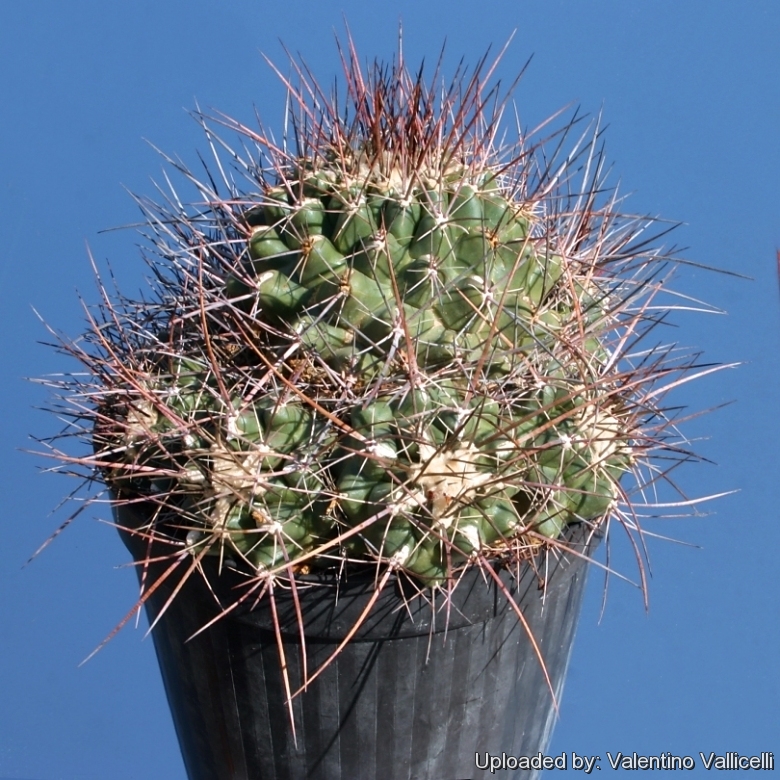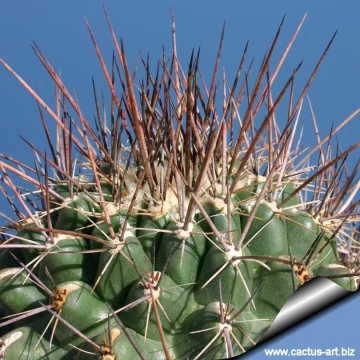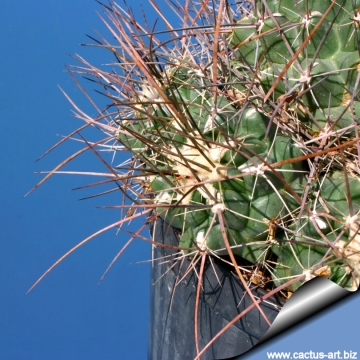= Thelocactus flavus Mosco & Zanov.
Cactus & Co. 3(1): 20, 22 (1999)
Accepted Scientific Name: Thelocactus conothelos subs. flavus (Mosco & Zanov.) Mosco & Zanov.
Bradleya 18: 63 (2000)

Thelocactus flavus (Thelocactus flavus) Photo by: Valentino Vallicelli
Origin and Habitat: Mexico, San Luis Potosí, restricted to a small area between Entronque Huizache and La Hincada,
Altitude range: Thelocactus conothelos subs. flavusSN|1073]]SN|1073]] grows at elevations of about 1200 to 1600 metres above sea level.
Habitat snd ecology: This species occurs in matorral xerofilo on limestone hills. Its range lies within the Meseta Central subregion of the Chihuahuan Desert ecoregion.
Synonyms:
See all synonyms of Thelocactus conothelos
back
Accepted name in llifle Database:Thelocactus conothelos (Regel & E. Klein bis) F.M.KnuthKaktus-ABC [Backeb. & Knuth] 358. 1936 [12 Feb 1936]Synonymy: 17
Accepted name in llifle Database:Thelocactus conothelos subs. argenteus (Glass & R.A.Foster) GlassGuía Identif. Cact. Amenazadas México 1: Th/con ssp. argenteus (1998 publ. 1997), as 'conothele'Synonymy: 4
Accepted name in llifle Database:Thelocactus conothelos subs. aurantiacus (Glass & R.A.Foster) GlassGuía Identif. Cact. Amenazadas México 1: Th/con ssp. aurantiacus (1998 publ. 1997), as 'conothele'Synonymy: 4
Accepted name in llifle Database:Thelocactus conothelos subs. flavus (Mosco & Zanov.) Mosco & Zanov.Bradleya 18: 63 (2000)Synonymy: 4
back
Description: Thelocactus conothelos subs. flavusSN|1074]]SN|1073]], also known as Thelocactus longispinusSN|1075]]SN|1075]] or Thelocactus panarottoanusSN|1073]]SN|1074]], solitary or slightly clustering and forming small clumps up to 40 cm across.
Stem: Globose, single heads 5-12 cm wide, olive green to purplish
Ribs: Completely divided into tubercles arranged in 8 and 13 spirals,
Tubercles: Conical , basally rhomboid 8-17 mm long.
Areoles: With glands.
Central spines: 4, 15-80 mm long, ochre to greyish, straight or slightly curved, acicular.
Radial spines: 3-5, 7-35 mm long, ochre to greyish, straight, acicular.
Flowers: 30-45 mm wide, yellow. Anthers and stigma yellow
Flowering time: Spring.
Taxonomic note: Panarottoanus is the same. It has priority over flavus at species rank, bur at subspecies rank flavus is the correct epithet to be used.
Subspecies, varieties, forms and cultivars of plants belonging to the Thelocactus conothelos group
Thelocactus conothelos and its subspecies argenteus and aurantiacus (and also the closely related Thelocactus flavus and Thelocactus garciae) are the most different from the other Thelocacti, both for flower morphology (in these species the primary filaments are inserted 4-5 mm above the base of the nectar chamber) and for seed micro-morphology (seed testa cells are conical and the surface of the cuticle is smooth). The seed-coat micro-morphology led Doweld to propose a new genus, Torreycactus, for them.
 Thelocactus conothelos (Regel & E. Klein bis) F.M.Knuth: (ssp. conothelos) is usually solitary and globose, with tubercles not obscured by spines, and has 1-4 central spines, 10—16 radials, and magenta to white flowers. Distribution: Tamaulipas, San Luis Potosi, and Nuevo Leon.
Thelocactus conothelos (Regel & E. Klein bis) F.M.Knuth: (ssp. conothelos) is usually solitary and globose, with tubercles not obscured by spines, and has 1-4 central spines, 10—16 radials, and magenta to white flowers. Distribution: Tamaulipas, San Luis Potosi, and Nuevo Leon. Thelocactus conothelos f. albiflora hort.: has white flowers. Distribution: near Matehuala, San Luis Potosi, Mexico.
Thelocactus conothelos f. albiflora hort.: has white flowers. Distribution: near Matehuala, San Luis Potosi, Mexico. Thelocactus conothelos subs. argenteus (Glass & R.A.Foster) Glass: is solitary and globose to cylindrical, with tubercles mostly obscured by spines, and has creamy white central spines, about 20 glassy and silvery grayish white, and pinkish purple flowers. Distibution: near La Ascension, Nuevo Leon, at 2100 m.
Thelocactus conothelos subs. argenteus (Glass & R.A.Foster) Glass: is solitary and globose to cylindrical, with tubercles mostly obscured by spines, and has creamy white central spines, about 20 glassy and silvery grayish white, and pinkish purple flowers. Distibution: near La Ascension, Nuevo Leon, at 2100 m. Thelocactus conothelos subs. aurantiacus (Glass & R.A.Foster) Glass: is solitary, globose to somewhat cylindrical, with tubercles mostly obscured by spines with bright yellow to orange-yellow flowers. Distribution: Aramberri, Nuevo Leon, at 1000-1200 m.
Thelocactus conothelos subs. aurantiacus (Glass & R.A.Foster) Glass: is solitary, globose to somewhat cylindrical, with tubercles mostly obscured by spines with bright yellow to orange-yellow flowers. Distribution: Aramberri, Nuevo Leon, at 1000-1200 m. Thelocactus conothelos f. aureiflora hort.: has bright yellow flowers.
Thelocactus conothelos f. aureiflora hort.: has bright yellow flowers. Thelocactus conothelos subs. flavus (Mosco & Zanov.) Mosco & Zanov.: has strongly tubercled stems with long spines and yellow flowers. Distribution: San Luis Potosí, between Huizache and La Hincada.
Thelocactus conothelos subs. flavus (Mosco & Zanov.) Mosco & Zanov.: has strongly tubercled stems with long spines and yellow flowers. Distribution: San Luis Potosí, between Huizache and La Hincada. Thelocactus garciae Glass & Mend.-Garc.: has flattened globose stems divided into tubercles, the areoles bear one or two glands. Distribution: vicinity of Bustamante.
Thelocactus garciae Glass & Mend.-Garc.: has flattened globose stems divided into tubercles, the areoles bear one or two glands. Distribution: vicinity of Bustamante. Thelocactus longispinus: not dissimilar to Thelocactus conothelos subs. flavus but with longer spines.
Thelocactus longispinus: not dissimilar to Thelocactus conothelos subs. flavus but with longer spines. Thelocactus panarottoanus Halda: same as Thelocactus conothelos subs. flavus.
Thelocactus panarottoanus Halda: same as Thelocactus conothelos subs. flavus. Thelocactus saussieri (F.A.C.Weber) A.Berger: usually has a darker flower color, less and shorter spines and grows flatter (= less cylindrical) than the type species. Distribution: Nuevo León and Tamaulipas, Mexico.
Thelocactus saussieri (F.A.C.Weber) A.Berger: usually has a darker flower color, less and shorter spines and grows flatter (= less cylindrical) than the type species. Distribution: Nuevo León and Tamaulipas, Mexico.
Notes: Thelocactus flavusSN|1074]]SN|1072]] is strictly related to Thelocactus garciaeSN|15121]]SN|15152]] This species has been well known for a long time and is sometimes listed in catalogues under the name Thelocactus longispinusSN|1065]]SN|1075]] n.n. which have also been distributed with the field number HK362. It has always been misidentified as Thelocactus tulensisSN|1075]]SN|1065]] and considered a yellow flowering form of it. At a glance, flavus resembles tulensis in the epidermis colour and the long central spines, but the relationship stops here.
There are indeed many remarkable differences between the two species. In flavus the areoles bear one or two glands, missing in tulensis; the radial spines are quite different in number and arrangement; the flowers of flavus are yellow with the primary stamens inserted above the receptacle base, while the flowers of tulensis are white to pink with the primary stamens inserted at the base of the receptacle. For the flower morphology and seed micro-morphology, flavus is, instead, referable to the Thelocactus conothelosSN|15152]]SN|15121]] complex. Thelocactus panarottoanusSN|1072]]SN|1074]] is the same.
Bibliography: Major references and further lectures
1) Edward Anderson “The Cactus family” Timber Press, Incorporated, 2001
2) Nathaniel Lord Britton, Joseph Nelson Rose “Cactaceae: Descriptions and Illustrations of Plants of the Cactus Family” vol. 4 The Carnegie Institution of Washington, Washington 1923
3) James Cullen, Sabina G. Knees, H. Suzanne Cubey "The European Garden Flora Flowering Plants: A Manual for the Identification of Plants Cultivated in Europe, Both Out-of-Doors and Under Glass" Cambridge University Press, 11/Aug/2011
4) David R Hunt; Nigel P Taylor; Graham Charles; International Cactaceae Systematics Group. "The New Cactus Lexicon" dh books, 2006
5) "Thelocactus flavus" http://www.thelocactus.cactus-mall.com/Species_Files/flavus.html
 Thelocactus flavus (Thelocactus flavus) Photo by: Cactus Art
Thelocactus flavus (Thelocactus flavus) Photo by: Cactus Art Thelocactus flavus (Thelocactus flavus) Photo by: Cactus Art
Thelocactus flavus (Thelocactus flavus) Photo by: Cactus Art Thelocactus flavus (Thelocactus flavus) Photo by: Cactus Art
Thelocactus flavus (Thelocactus flavus) Photo by: Cactus Art One month old seedlings. (Thelocactus flavus) Photo by: Carolina González
One month old seedlings. (Thelocactus flavus) Photo by: Carolina GonzálezCultivation and Propagation: Easy to cultivate. Water moderately from Spring to Autumn. Keep dry in winter, can tolerate frequent moderate frost, above approx -7C, Sun Summer grower needs full sun exposures.
Reproduction: Nearly always from seed, since the plant rarely produces plantlets.















